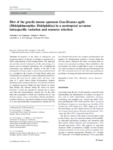Use este identificador para citar ou linkar para este item:
http://www.alice.cnptia.embrapa.br/alice/handle/doc/974622| Título: | Diet of the gracile mouse opossum Gracilinanus agilis (Didelphimorphia: Didelphidae) in a neotropical savanna: intraspecific variation and resource selection. |
| Autoria: | CAMARGO, N. F. de  RIBEIRO, J. F.   CAMARGO, A. J. A. de   VIEIRA, E. M.   |
| Afiliação: | NÍCHOLAS F. DE CAMARGO, UNIVERSIDADE DE BRASILIA; JULIANA F. RIBEIRO, UNIVERSIDADE DE BRASILIA; AMABILIO JOSE AIRES DE CAMARGO, CPAC; EMERSON M. VIEIRA, UNIVERSIDADE DE BRASILIA. |
| Ano de publicação: | 2013 |
| Referência: | Acta Theriologica [on-line], Poland, 04 June 2013. |
| Conteúdo: | Investigation of the effect of endogenous and exogenous factors on the diet of animals is necessary for a better understanding of their feeding habits. This approach can provide relevant information on the autoecology of a species and its ecological interactions. We investigated the composition and intraspecific variation in the diet of the marsupial Gracilinanus agilis in areas of dry woodland forests (i.e., cerradão) in the Cerrado of Central Brazil, taking into consideration the availability of prey (arthropods) in the environment. We found insects, spiders, birds, and fruits in the scats of G. agilis. Insects (orders Hymenoptera, Isoptera, Hemiptera, and Coleoptera) and fruits were the most frequently consumed resources. Males fed more heavily on insects than females did, whereas during the warm?wet season (October to April), the reproductive females fed on insects more than the nonreproductive females did. On the other hand, the consumption of fruits and vertebrates did not vary between seasons, sexes, or according to female reproductive condition. Moreover, reproductive females fed more frequently on ants and beetles than nonreproductive females did. We also detected both positive (for Isoptera and Hemiptera) and negative (for Hymenoptera) selection of insects during the cool?dry season, whereas in the warm?wet season, these resources were consumed according to their availability in the environment. Our study revealed that G. agilis is an insectivore?omnivore species, but fruits also are a relevant part of its diet. This marsupial seemed to select their prey qualitatively according to its energy demands and nutritional requirements. |
| Thesagro: | Cerrado Dieta Marsupial Inseto Seleção |
| NAL Thesaurus: | Savannas Diet Insects Selection methods Brazil |
| Palavras-chave: | Marsupialia |
| ISSN: | 2190-3743 |
| Digital Object Identifier: | 10.1007/s13364-013-0152-y |
| Tipo do material: | Artigo de periódico |
| Acesso: | openAccess |
| Aparece nas coleções: | Artigo em periódico indexado (CPAC)  |
Arquivos associados a este item:
| Arquivo | Descrição | Tamanho | Formato | |
|---|---|---|---|---|
| 33771.pdf | 262,34 kB | Adobe PDF |  Visualizar/Abrir |









